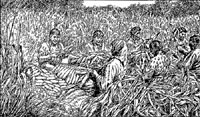Mandan Village Life
Corn Husking Story
Blackfeet Men and Women
Hunting Buffalo
Blackfeet War Party
| | |
Corn Husking
In Arikara, Mandan, and Hidatsa villages, women owned the agricultural gardens planted along the banks of the Missouri River. Working in family groups or as part of a ceremonial societies, gangs of girls and women planted crops in the spring, weeded together in summer, and gathered the harvest in the fall.
Waheenee (Buffalo Bird Woman) was born in 1839. Her memoir contains a description of the corn harvests that took place when she was a young girl.
After gathering the corncobs, the women would invite young men to husk and prepare them for storage. They paid their workers with an immense feast of buffalo and corn stew. It was the “busiest and happiest time of all the year,” Waheenee recalled.
Gilbert L. Wilson. “The Corn Husking,” in Waheenee,
an Indian Girl’s Story Told by Herself to Gilbert L. Wilson,
1981.
|

| Click to Read Transcript | National Park Service |
|

